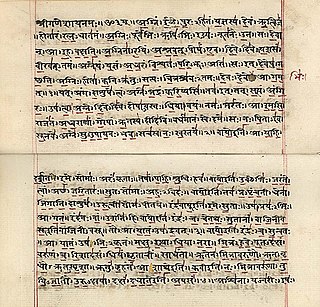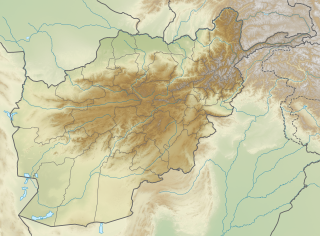Related Research Articles
Zoroastrianism or Mazdayasna is one of the world's oldest continuously practiced religions. It is a multi-faceted faith centered on a dualistic cosmology of good and evil and an eschatology predicting the ultimate conquest of evil with theological elements of henotheism, monotheism/monism, and polytheism. Ascribed to the teachings of the Iranian-speaking spiritual leader Zoroaster, it exalts an uncreated and benevolent deity of wisdom, Ahura Mazda, as its supreme being. Historical features of Zoroastrianism, such as messianism, judgment after death, heaven and hell, and free will may have influenced other religious and philosophical systems, including Second Temple Judaism, Gnosticism, Greek philosophy, Christianity, Islam, the Baháʼí Faith, and Buddhism.
Zoroaster, also known as Zarathustra, Zarathushtra Spitama or Ashu Zarathushtra, was an ancient Iranian prophet who founded what is now known as Zoroastrianism. His teachings challenged the existing traditions of the Indo-Iranian religion and inaugurated a movement that eventually became the dominant religion in Ancient Persia. He was a native speaker of Old Avestan and lived in the eastern part of the Iranian Plateau, but his exact birthplace is uncertain.

Ahura Mazda is the creator and highest deity of Zoroastrianism. Ahura Mazda is the first and most frequently invoked spirit in the Yasna. The literal meaning of the word Ahura is "lord," and that of Mazda is "wisdom."

Asuras are a class of beings or power-seeking clans related to the more benevolent Devas in Hinduism.

Avestan, also known historically as Zend, comprises two languages: Old Avestan and Younger Avestan. The languages are known only from their use as the language of Zoroastrian scripture, from which they derive their name. Both are early Iranian languages, a branch of the Indo-Iranian languages within the Indo-European family. Its immediate ancestor was the Proto-Iranian language, a sister language to the Proto-Indo-Aryan language, with both having developed from the earlier Proto-Indo-Iranian. As such, Old Avestan is quite close in grammar and lexicon to Vedic Sanskrit, the oldest preserved Indo-Aryan language.

Mithra commonly known as Mehr is the Zoroastrian Angelic Divinity (yazata) of Covenant, Light, and Oath. In addition to being the divinity of contracts, Mithra is also a judicial figure, an all-seeing protector of Truth, and the guardian of cattle, the harvest, and of the Waters.
Vedic Sanskrit was an ancient language of the Indo-Aryan subgroup of the Indo-European languages. It is attested in the Vedas, texts compiled over the period of the mid-2nd to mid-1st millennium BCE. It was orally preserved, predating the advent of Brahmi script for several centuries.
The Gathas are 17 Avestan hymns believed to have been composed by Zarathushtra (Zoroaster) himself. They form the core of the Zoroastrian liturgy. They are arranged in five different modes or metres.
In Zoroastrianism, the Amesha Spenta are a class of seven divine entities emanating from Ahura Mazda, the highest divinity of the religion. Later Middle Persian variations of the term include the contraction 'Ameshaspand' as well as the specifically Zoroastrian 'Mahraspand' and 'Amahraspand'.
Vohu Manah is the Avestan language term for a Zoroastrian concept, generally translated as "Good Purpose", "Good Mind", or "Good Thought", referring to the good moral state of mind that enables an individual to accomplish their duties. Its Middle Persian equivalent, as attested in the Pahlavi script texts of Zoroastrian tradition, is 𐭥𐭤𐭥𐭬𐭭 Wahman, which is a borrowing of the Avestan language expression and has the same meaning, and which continues in New Persian as بهمن Bahman and variants. Manah is cognate with the Sanskrit word Manas suggesting some commonality between the ideas of the Gathas and those of the Rigveda. The opposite of Vohu Manah is Aka Manah, "evil purpose" or "evil mind".
Daeva is an Avestan language term for a particular sort of supernatural entity with disagreeable characteristics. In the Gathas, the oldest texts of the Zoroastrian canon, the daevas are "gods that are rejected". This meaning is – subject to interpretation – perhaps also evident in the Old Persian "daiva inscription" of the 5th century BCE. In the Younger Avesta, the daevas are divinities that promote chaos and disorder. In later tradition and folklore, the dēws are personifications of every imaginable evil.
Yazata is the Avestan-language word for a Zoroastrian concept with a wide range of meanings but generally signifying a divinity. The term literally means "worthy of worship or veneration", and is thus, in this more general sense, also applied to certain healing plants, primordial creatures, the fravashis of the dead, and to certain prayers that are themselves considered holy. The yazatas collectively are "the good powers under Ahura Mazda", who is "the greatest of the yazatas".
Vedic meter refers to the poetic metre in the Vedic literature. The study of Vedic metre, along with post-Vedic metre, is part of Chandas, one of the six Vedanga disciplines.
Asha is a Zoroastrian concept with a complex and highly nuanced range of meaning. It is commonly summarized in accord with its contextual implications of 'truth' and 'right(eousness)', 'order' and 'right working'. For other connotations, see meaning below. It is of cardinal importance to Zoroastrian theology and doctrine. In the moral sphere, aṣ̌a/arta represents what has been called "the decisive confessional concept of Zoroastrianism". The opposite of Avestan aṣ̌a is 𐬛𐬭𐬎𐬘 druj, "deceit, falsehood".
Karl Friedrich Geldner was a German linguist best known for his analysis and synthesis of Avestan and Vedic Sanskrit texts.
Sanskrit prosody or Chandas refers to one of the six Vedangas, or limbs of Vedic studies. It is the study of poetic metres and verse in Sanskrit. This field of study was central to the composition of the Vedas, the scriptural canons of Hinduism, so central that some later Hindu and Buddhist texts refer to the Vedas as Chandas.

The Rigveda is an ancient Indian collection of Vedic Sanskrit hymns. It is one of the four sacred canonical texts (śruti) of Hinduism known as the Vedas.

Koh e Hindu is a mountain of the Hindu Kush in Afghanistan. It is located in near Shakardara District and Mir Bacha Kot District, Kabul Province.

Ancient Iranian religion refers to the ancient beliefs and practices of the Iranian peoples before the rise of Zoroastrianism.

Hans-Peter Schmidt was a German Indologist and Iranologist who was Professor of Indo-Iranian Studies at the University of California, Los Angeles. He specialized in the comparative study of the Gathas and Vedas.
References
- ↑ Iran Culture House, Indo Iran Cultural Society, K.R. Cama Oriental Institute (1974). يادنامۀ كوروش بمبئي: Essays on Indology and Indo-Iran Relations in Memory of Cyrus Celebration Held in the City of Bombay on the 2500th Anniversary of the Foundation of the Persian Empire, p.86
- ↑ Bihar Research Society (1926). The Journal of the Bihar Research Society, Volume 12, p.129.
- ↑ Ganga Prasad (2000). Fountain-head of Religion: Being a Comparative Study of the Principal Religions of the World and a Manifestation of Their Common Origin from the Vedas, p.94-95. ISBN 1585090549
| This Zoroastrianism-related article is a stub. You can help Wikipedia by expanding it. |